By: Rusiraj Pattanayak
Baba Kakharua Baidyanath.
Now a days Lord God hesitates to appear before us, but He used to do/appear in the older days.
Manatri (ମାଣତ୍ରୀ) is located to the south-east of Badasahi and 50 kms from Baripada. The place is in the pilgrims/devotees eyes throughout Odisha and some neighboring states for the temple of its presiding deity Baba Kakharua Baidyanath.The people here were required to pay three Manas [ତିନି ମାଣ] of paddy to the deity, a practice not yet altogether given up to the year late 1940s.The name Manatraya[ମାଣତ୍ରୟ] or Manatri[ମାଣତ୍ରୀ] literally means three Manas[ମାଣ]) is said to have originated this way.

Baba Kakharua Baidyanath [ବାବା କଖାରୁଆ ବୈଦ୍ୟନାଥ] is believed to possess immense power. He is known as Jagrata Devata. He readily grants & sanctifies all prayers.Thousands of people come here from distant parts of the states to present offerings to the deity. During ShivaRaatri, Jatras and Mela are held here in honor of this God. Nearly three lakh pilgrims assemble to join in this grand festival & give offerings to the temple.
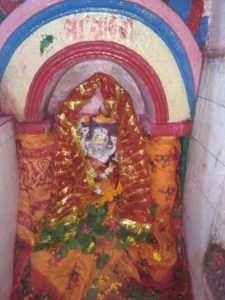
History of the Temple
Tradition sings that a King of the Soma-Vansha [ସୋମ ବଂଶ] was attacked with white leprosy, his whole body becoming white like gourd [କଖାରୁ]. This circumstance led his people to call him “kakharua” [କଖାରୁଆ]. With a view to get rid of the disease, Kakharua came to [Deoghar, Jharkhand ଦେଓଘର,ଝାରଖଣ୍ଡ] & bowed low, prostrated [ସାଷ୍ଟାଙ୍ଗ ପ୍ରଣିପାତ] himself before Vaidyanatha and remained in that condition without food, until the God granted his prayer. The God appeared to him in a divination/vision and said, “I am lying concealed under water in praganna kunda in Mayurbhanj, pick me up and worship me and your leprosy will be cured.”
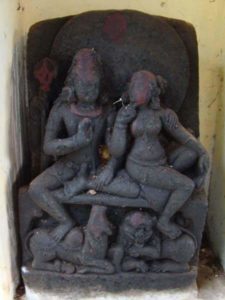
Accordingly, the King came to this place and made a search but couldn’t find the deity. He again fasted and remained there in the same condition, prostrating himself. This time the command of the God was, “Throw stones into the water and you shall get me”.
Then stones were thrown into the water; and no sooner had this been done, then Shiva-Linga was found floating on the surface of the water . At the sight of the Almighty the Raja’s leprosy was cured. With a view to commemorate the event, he erected a temple on the spot where the Shiva -Linga had appeared and set it up there amidst the great rejoicings of the people. From the fact that the King’s disease, which gave him the look of a [kakharu/gourd], was cured by Vaidyanatha, therefore the God Came to be christened Baba Kakharua Baidyanath.
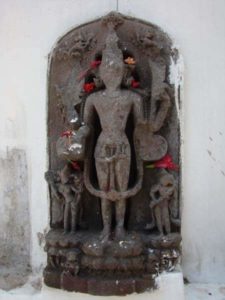
By the side of the above temple, is an old water reservoir. Water is to be found in this kunda[କୁଣ୍ଡ] throughout the year and the place is connected with the river Gangahara [ଗଙ୍ଗାହର].The river and the kunda surround the Vaidyanatha Khetra on three sides.
The architectural design and workmanship of the temple are that of the 15th or 16th century. We also find that in the Madala Panji of Lord Jagannath, the King who reigned from 1454 ad to 1456AD, was assassinated by his minister Govinda Bidyadhara [ଗୋବିନ୍ଦ ବିଦ୍ୟାଧର], who having murdered King Kakharua [କଖାରୁଆ] & the whole royal family, secured the throne for himself. At Managovindapur, which is only a mile to the east of Manatri, extensive ruins of a castle were still to be seen up to 1950 . People believe that this castle was built by Govinda Vidyadhara who probably called himself Managovinda on coming to the throne. The descendants of Managovinda were once living in a village called [Tentul- Munda] now known as “Tentala (ଟେଂଟଲ)”.
(Tehsil Name : Badasahi, 6.4 kms to Manatri.)
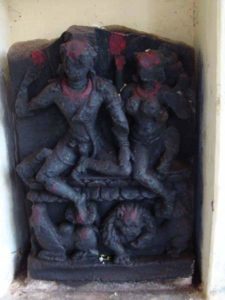
Architecture of the Temple
The Temple is divided into three parts like Natamandira, Jagamohana and Garbagriha/inner sanctum. The Garbagruha & the Jagamohana are known to be the work of Kakharua. The Natamandira was built by King Jadunath Bhanj .On both sides of the Natamandira, are two small Shiva Temples built by King Srinatha Bhanj & Damodara Pattanayak Chamukarana.
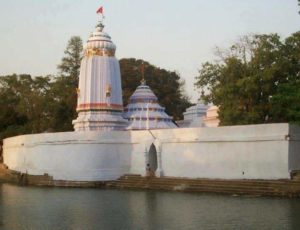
King Kakharua contented himself with erecting only the main temple. His minister after usurping [ଅନ୍ୟାୟ ଭାବେ ସିଂହାସନ ଦଖଲ କରିଥିଲେ] the throne by treachery, not only built a castle at Managovindapur, but also erected a lofty and extensive Kurmabedha[କୂର୍ମବେଢା]/wall around the temple. In fact this wall appeared like a rampart of a fort. Over it there was a space where the King and his general could sit, & a strong parapet from which five hundred soldiers could fire cannons or discharge arrows.

Therefore, neither Kakharua nor Govinda was a member of the Bhanja Family & this explains that the construction of temple was the work of a foreign King. But from the Madala Panji, it is mentioned that King Govinda Deva married his sister into the family of Bhanja Rajas of Mayurbhanj.
It is also on record that his sister’s son, Raghu Bhanja Chottaraya, rose in rebellion against his maternal uncle & had a hard struggle with him at Chitrapur on opposite side of the Mahanadi. We learn that Govinda Deva was nearly related to the Bhanja Families.

Photo Courtsey: Satyajit Upadhaya